Emily Lakdawalla • Feb 10, 2011
Snapshots from Space: Voyager views of the Great Red Spot, Björn Jönsson
I've got a new column in the Planetary Society's member magazine, The Planetary Report, called "Snapshots from Space." In each issue I'll be highlighting one really cool amateur-processed image. I'm excited to have the opportunity to help these people get their work published! (And if you'd like to see amateurs' work in print, as well as read feature articles about space exploration like this month's by Marc Buie about mapping Pluto using Hubble, join the Planetary Society to start receiving The Planetary Report!)
It didn't take me long to pick which image I'd use for the inaugural Snapshots from Space column. I chose Icelandic amateur Björn Jónsson's fantastic new view of Jupiter's Great Red Spot from Voyager 1. It was first posted at unmannedspaceflight.com; I posted it here, too. Björn has produced several other fine Voyager mosaics on Jupiter, including this one showing the red spot in more regional context and this one from Voyager 2, which is even closer in on the Red Spot.
For each "Snapshots from Space" feature, I'll be creating a poster that you can get at the Planetary Society store. This one is spectacular, featuring both of Björn's Great Red Spot mosaics as well as one of his more distant views; it's printed at 23 by 35 inches or about A1 size.

Finally, as part of Snapshots from Space, I'm going to try to find out more about what makes amateur image processors tick. I asked Björn several questions, which he was kind enough to take the time to answer.
1. When did you first start working with space images?
Along time ago really but the real start can probably be defined as 1993 or so when I got the 12 Voyager CDs with a selection of images from the Jupiter and Saturn flybys and all of the Uranus and Neptune images. This was the first time I got access to raw spacecraft data.
2. What are your goals with these images -- what drives you to spend your time doing this work?
I'm not sure I really know - astronomy and especially the solar system is just something I've been interested in since I was a kid. Sometimes I simply want to know what these exotic places look like. In some cases it's the desire to bring something new or interesting out of old (or even recent) data. In many cases a combination of these.
3. What software do you use to do your work?
Software written by myself for specialized tasks like calibrating the images, reprojecting and warping them and for doing geometric calculations like reverse engineering the viewing geometry etc. Photoshop for image cleanup following calibration and also for postprocessing and various cosmetic enhancements. Also various other software but this is what I primarily use.
4. What is your day job?
Software engineer.
If you'd like to see your work featured in The Planetary Report's Snapshots from Space column, please send me an email!
The Time is Now.
As a Planetary Defender, you’re part of our mission to decrease the risk of Earth being hit by an asteroid or comet.
Donate Today

 Explore Worlds
Explore Worlds Find Life
Find Life Defend Earth
Defend Earth


